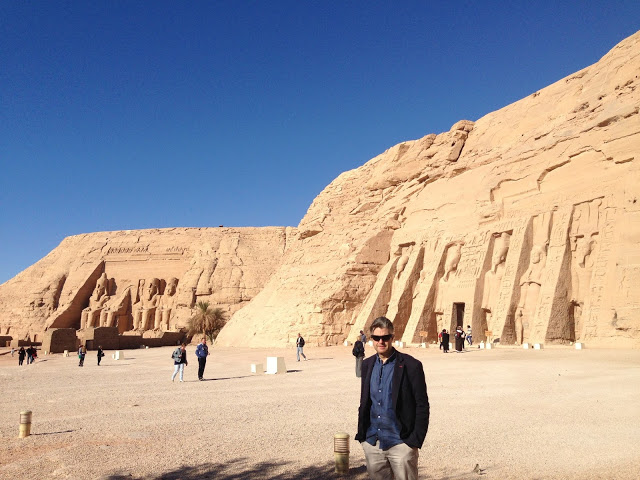
Temple of Hatshepsut { Temple Of Deir el-Bahri }
Hatshepsut (or Hatchepsut, pronounced meaning Foremost of Noble Ladies, (1508–1458 BC) was the fifth pharaoh of the eighteenth dynasty of Ancient Egypt. She is generally regarded by Egyptologists as one of the most successful pharaohs, reigning longer than any other woman of an indigenous Egyptian dynasty.
Although poor records of her reign are documented in diverse ancient sources, Hatshepsut was described by early modern scholars as only having served as a co-regent from about 1479 to 1458 BC, during years seven to twenty-one of the reign previously identified as that of Thutmose III. Today it is generally recognized[by whom?] that Hatshepsut assumed the position of pharaoh and the length of her reign usually is given as twenty-two years, since she was assigned a reign of twenty-one years and nine months by the third-century B.C. historian, Manetho, who had access to many records that now are lost. Her death is known to have occurred in 1458 BC, which implies that she became pharaoh circa 1479 .
Although it was uncommon for Egypt to be ruled by a woman, the situation was not unprecedented. As a regent Hatshepsut was preceded by Merneith of the first dynasty, who was buried with the full honors of a pharaoh and may have ruled in her own right. Nimaethap of the third dynasty may have been the dowager of Khasekhemwy, but certainly acted as regent for her son, Djoser, and may have reigned as pharaoh in her own right. Queen Sobekneferu of the Twelfth Dynasty is known to have assumed formal power as ruler of “Upper and Lower Egypt” three centuries earlier than Hatshepsut.
Ahhotep I, lauded as a warrior queen, may have been a regent between the reigns of two of her sons, Kamose and Ahmose I, at the end of the seventeenth dynasty and the beginning of Hatshepsut’s own eighteenth dynasty. Amenhotep I, also preceding Hatshepsut in the eighteenth dynasty, probably came to power while a young child and his mother, Ahmose-Nefertari, is thought to have been a regent for him. Other women whose possible reigns as pharaohs are under study include Akhenaten’s possible female co-regent/successor (usually identified as either Nefertiti or Meritaten) and Twosret. Among the later, non-indigenous Egyptian dynasties, the most notable example of another woman who became pharaoh was Cleopatra VII, the last pharaoh of Ancient Egypt.
In comparison with other female pharaohs, Hatshepsut’s reign was long and prosperous. She was successful in warfare early in her reign, but generally is considered to be a pharaoh who inaugurated a long peaceful era. She re-established trading relationships lost during a foreign occupation and brought great wealth to Egypt. That wealth enabled Hatshepsut to initiate building projects that raised the calibre of Ancient Egyptian architecture to a standard, comparable to classical architecture, that would not be rivaled by any other culture for a thousand years.
Hatshepsut was given a reign of about twenty-two years by ancient authors. Josephus writes that she reigned for twenty-one years and nine months, while Africanus states her reign lasted twenty-two years, both of whom were quoting Manetho. At this point in the histories, records of the reign of Hatshepsut end, since the first major foreign campaign of Tuthmosis III was dated to his twenty-second year, which also would have been Hatshepsut’s twenty-second year as pharaoh. Dating the beginning of her reign is more difficult, however. Her father’s reign began in either 1506 or 1526 BC according to the low and high chronologies, respectively. The length of the reigns of Tuthmosis I and Tuthmosis II, however, cannot be determined with absolute certainty. With short reigns, Hatshepsut would have ascended the throne fourteen years after the coronation of Tuthmosis I, her father. Longer reigns would put her ascension twenty-five years after Tuthmosis I’s coronation. Thus, Hatshepsut could have assumed power as early as 1512 BC, or, as late as 1479 BC.
The earliest attestation of Hatshepsut as pharaoh occurs in the tomb of Senenmut’s parents where a collection of grave goods contained a single pottery jar or amphora from the tomb’s chamber—which was stamped with the date Year 7. Another jar from the same tomb—which was discovered in situ by a 1935–1936 Metropolitan Museum of Art expedition on a hillside near Thebes—was stamped with the seal of the ‘God’s Wife Hatshepsut’ while two jars bore the seal of ‘ The Good Goddess Maatkare. ‘The dating of the amphorae, “sealed into the [tomb’s] burial chamber by the debris from Senenmut’s own tomb,” is undisputed which means that Hatshepsut was acknowledged as the king of Egypt by Year 7 of her reign. She wanted to rule like a male, not to be outdone by the previous male pharaohs. She demanded to be called king, and his majesty.
Hatshepsut died as she was approaching, what we would consider middle age given typical contemporary lifespans, in her twenty-second regnal year. The precise date of Hatshepsut’s death—and the time when Thutmose III became sole pharaoh of Egypt—is considered to be Year 22, II Peret day 10 of their joint rule, as recorded on a single stela erected at Armant or January 16, 1458 BC. This information validates the basic reliability of Manetho’s kinglist records since Thutmose III and Hatshepsut’s known accession date was I Shemu day 4. (i.e.: Hatshepsut died 9 months into her 22nd year as Manetho writes in his Epitome for a reign of 21 years and 9 months) No contemporary mention of the cause of her death has survived. If the recent identification of her mummy (see below) is correct, however, the medical evidence would indicate that she suffered from diabetes and died from bone cancer which had spread throughout her body while she was in her fifties. It also would suggest that she had arthritis and bad teeth.
No Comments
Leave a Reply:
You must be logged in to post a comment.






